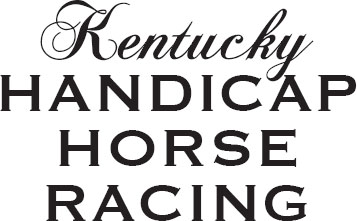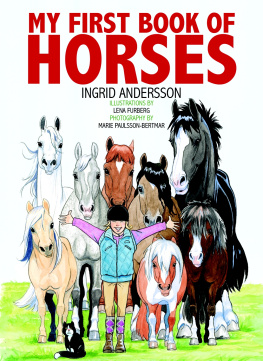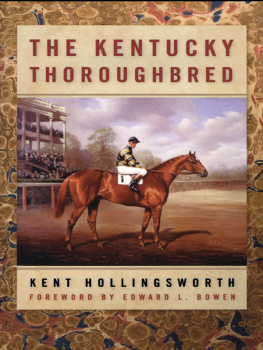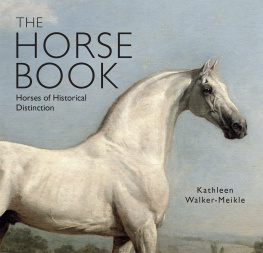

Published by The History Press
Charleston, SC 29403
www.historypress.net
Copyright 2014 by Melanie Greene
All rights reserved
First published 2014
e-book edition 2014
ISBN 978.1.62585.002.7
Library of Congress CIP data applied for.
print edition ISBN 978.1.62619.469.4
Notice: The information in this book is true and complete to the best of our knowledge. It is offered without guarantee on the part of the author or The History Press. The author and The History Press disclaim all liability in connection with the use of this book.
All rights reserved. No part of this book may be reproduced or transmitted in any form whatsoever without prior written permission from the publisher except in the case of brief quotations embodied in critical articles and reviews.
CONTENTS
FOREWORD
In her examination of the history of Kentucky-bred handicap horses, Melanie Greene has done a long overdue paean to those past champions that labored under seemingly impossible imposts and still managed to win consistently. By restricting her book to Kentucky-breds, she has had to omit such great handicap horses as Stymie, Gallorette and Dr. Fager, to name just a few. However, it would be a monumental task to discuss all the great weight carriers in Thoroughbred history while still keeping this book at a reasonable length. She has done a commendable job in picking the Kentucky-breds that have made the final cut.
As Ms. Greene points out, the handicap horses that consistently raced while carrying 130 pounds or more have vanished from the horse-racing scene. Today, there are so many lucrative stakes races for older horses that a trainer is able to pick and choose what race his or her champion will run in, and every racing secretary is aware that a race in which that trainers horse would be required to carry 135 pounds would not be on the short list.
In concluding that the era of serious handicap racing is over, I have mixed feelings concerning its disappearance. No other sport punishes its most gifted participants because of his or her outstanding ability. One can marvel while watching the replay of the 1976 Marlboro Cup, in which Forego overcame his assigned weight of 137 pounds and a sloppy track that he despised to defeat that years Travers winner, Honest Pleasure, who was carrying a feathery 119 pounds. However, it is with some sadness that one reads of the great Discovery finishing last in the 1936 Merchants and Citizens Handicap while carrying 143 pounds. The winner of that race, the gifted filly Esposa, was given a 43-pound weight advantage. (Two weeks later, in the weight-for-age Whitney, Discovery beat Esposa by ten lengths while conceding five pounds to that rival.) It should also be noted that racing fans were denied the privilege of watching the immortal Man o War race as a four-year-old after his owner, Sam Riddle, was informed that his champions normal impost would be 145 pounds.
So sit back and enjoy reading how the great weight carriers of their time did something that will never be seen again in racing history.
ALLAN CARTER, HISTORIAN
National Museum of Racing
PREFACE
Jesse Owens never had to race with ankle weights. Carl Lewis never gave anyone a head start. But in handicap racing, good Thoroughbreds are penalized. They must carry more weight than less talented opponents. Great Thoroughbreds carry significantly more weight; the better they are, the heavier the penalty.
This book documents a once-celebrated type of horse racethe handicapin which horses are assigned weights based on their past performances as a way to try to create evenly matched fields. The better the horse, the heavier the weight assigned. In the twentieth century, handicaps frequently determined champion honors, especially for older horses, and were a popular attraction for geldings, which, unlike colts, had no need to be hastily retired to stand at stud.
It was Kentucky-bred horses that won under the heaviest of weights, dominating the handicap division year after year. These equine stars brought recognition to the Sport of Kings and became renowned athletes for their courage, fortitude and durability. Despite the historical importance of handicap racing and the significant contributions made by the Kentucky breeding and racing industries, handicapping has become a forgotten chapter in racing history and, as yet, remains unrecorded in a comprehensive volume.
Today, the majority of stakes races, including those that were formerly designated as handicaps, are weight-for-age events, and horses are rarely asked to carry more than 126 pounds. Champion handicappers are no longer recognized in a separate awards division. The ability to win under heavy weight has become a lost art. This book focuses on the racing careers and feats of leading Kentucky-bred racehorses that were crowned champions in the handicap division based on their ability to win under heavy weight assignments.
Admittedly, it is not a complete study of racings greatest handicappers, as it focuses entirely on male racehorses, excluding many fantastic fillies and mares that won under heavy weight assignments, as well as a great many more horses bred in other states or countries that set the racing world afire with new speed and weight records. Nonetheless, this book serves as a tribute to the handicap and profiles some of the greatest equine weight carriers of racings past.
ACKNOWLEDGEMENTS
Cathy Schenck at Keeneland Library (Lexington, Kentucky), who provided invaluable resources and photographs.
Victoria Tokarowski, curator at the National Museum of Racing and Hall of Fame (Saratoga Springs, New York), for her hours spent researching, locating and scanning photographs.
Allan Carter, historian at the National Museum of Racing and Hall of Fame, for writing the foreword.
Heather Rohde for painting the beautiful portraits of the champions profiled in the book.
Linda Rainey at the Canadian Horse Racing Hall of Fame (Toronto, Ontario), who provided a photograph of Ted Atkinson and Tom Fool.
Lisa J. Hall at the Aiken Thoroughbred Racing Hall of Fame and Museum (Aiken, South Carolina) for providing a photo of Devil Diver.
The staff at Memorial University of Newfoundlands Digital Media Centre, who assisted with scanning and photo editing.
The staff at The History Press, especially my commissioning editor, Banks Smither.
Erika Steeves, for proofreading the manuscript and offering feedback and suggestions.
Chapter 1
HISTORY OF THE HANDICAP
The mark of a great horse is to carry weight over distancesPut in simple terms, a horse cannot be considered great until he has wonhopefully repeatedly at the classic distance of a mile and a quarter or more. And he cannot be considered great until he has carried more than scale weight, in practical terms 130 pounds or more, and given away chunks of weight to good competition.
ORIGINS OF THE HANDICAP
Hand-in-cap was a lottery game dating back to the fourteenth century.
The person who offered up the lesser-valued item had to pay up with the amount decreed by the referee. If in agreement with the swap, the players would then reach into the cap and draw out loose change. This change was symbolic and did not become part of the appraisal fee. If both players drew out coins, the exchange of items was carried out, and the referee took the forfeit money. If neither player drew out coins, the referee again took the forfeit money, and the exchange was not made. If only one player took out coins, he was entitled to the forfeit money, and no exchange was made.
Next page









